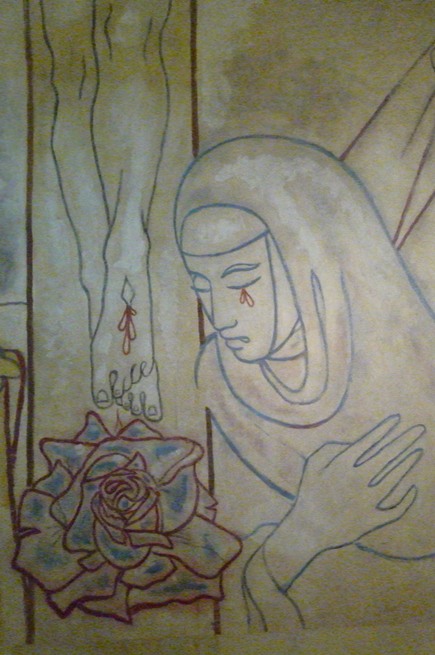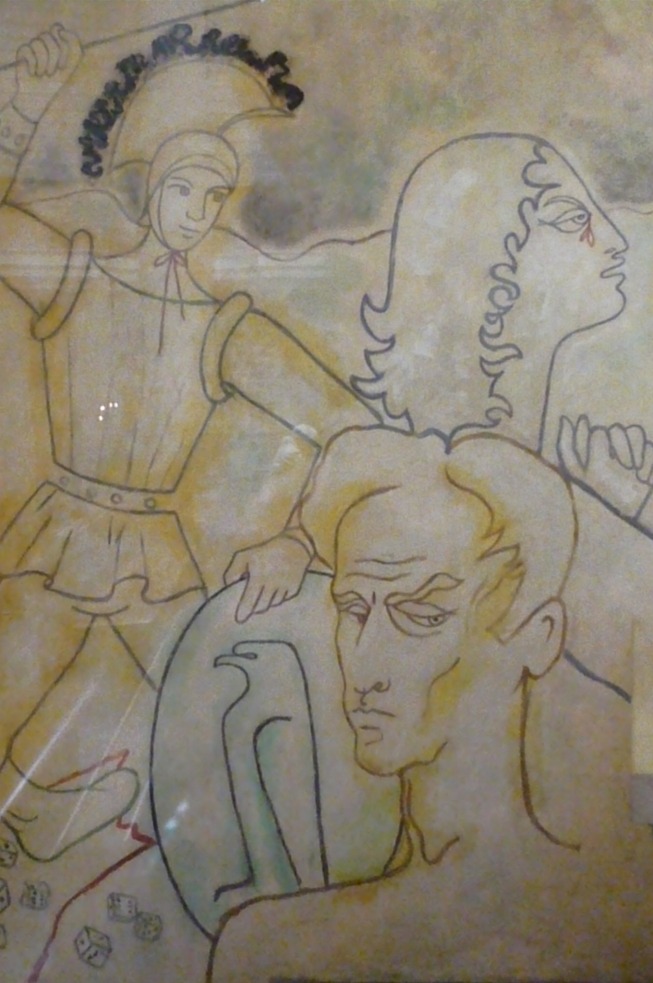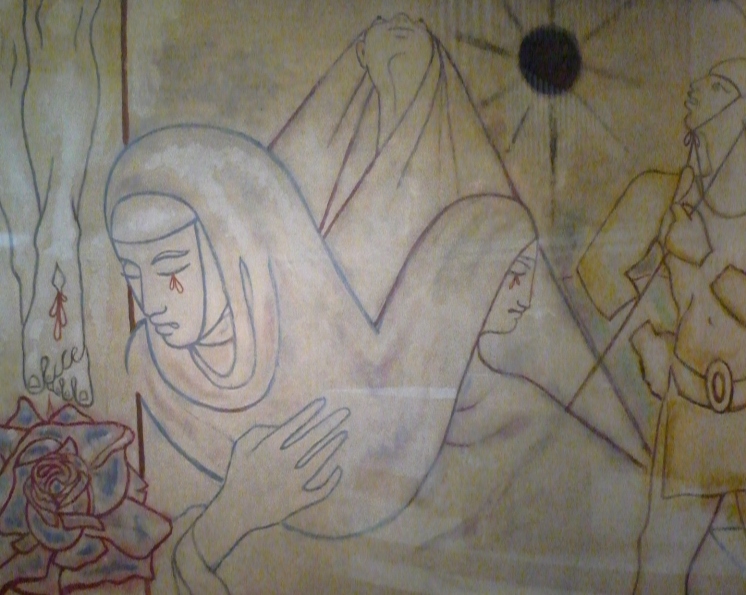Artists



Cocteau, Jean - by Jonathan Evens
Notre Dame de France, London: Jean Cocteau
by Jonathan Evens
Notre Dame de France, the Roman Catholic Francophone Chaplaincy in London run by the Marist Fathers, is squeezed between buildings in Leicester Place, which in turn is squeezed between the colour and commerce of Leicester Square’s crowded cinemas and the sushi, Szechuan, satay and stir fry served in Chinatown’s 78 restaurants. It feels like a historic anomaly, with origins going back to 1861 when the area had a large French population and the Marist Fathers established the mission on the site. Yet it maintains a valid and vibrant ministry with ever-growing calls on its pastoral services as the number of French-speakers in London has grown.
Time and space seem suspended in the light, airy and open expanse of this circular church hidden behind the bluff brick façade on Leicester Place; the building looking like a town house with a narrow arched and carved porch added to it. The unusual circular interior derives from the buildings original manifestation as ‘Burford’s Panorama’, built as a tourist attraction with a rotunda 90ft in diameter decorated with a scenic cylindrical painting by the Irish artist Robert Barker in 1796. The original building, which had been transformed into a church by the French architect Louis Auguste Boileau, was bombed out in the 1940s and almost entirely rebuilt from 1953-55.
From the time of its rebuilding onwards, Cultural Attaché René Varin encouraged the creation of a sacred space, which would honour France by approaching eminent artists of the time such as Georges-Laurent Saupique (base relief carving of Our Lady of Mercy, 1953) and Boris Anrep (Mosaic of the Nativity, 1954). The most significant and perhaps controversial artist was Jean Cocteau.
On entry to the church, however, it is both the rotunda and, beneath it, the Aubusson tapestry by Dom Robert depicting paradise on earth to which eyes are immediately drawn. In a rather sweet and slightly sentimental image, this tapestry depicts the new Eve walking towards us, surrounded by the vegetation, flowers and creatures of the natural world, as a pure new bride. A quotation from Proverbs refers to Wisdom at the side of God in creation ‘like a master craftsman, ever at play in his presence.’
Dom Robert was a friend of Jean Cocteau who, over the course of eight days in November 1959 (when he was in London promoting his film Le Testament d’Orphee), painted murals of the annunciation, crucifixion, and assumption in the Our Lady’s Chapel at Notre Dame de France. Cocteau had received a honorary doctorate from Oxford University with the support of René Varin and then asked if there was anything he could do in return. Varin suggested that he decorate the chapel at Notre Dame de France.
Such was Cocteau’s fame at the time that a screen was erected to hold back the public and press while he painted the murals. It is said that he arrived each morning at about 10am and always began by lighting a candle. While working on the drawings, he was heard talking to the Virgin Mary: ‘O you, most beautiful of women, loveliest of God’s creatures, you were the best loved. So I want you to be my best piece of work too … I am drawing you with light strokes ... You are the yet unfinished work of Grace’ (Les murs de Jean Cocteau, written by Carole Weissweiller, photographed by Suzanne Held, Hergé, 1998).
Once he had finished his task, Cocteau was sad to leave: ‘I am sorry to go, as if the wall of the chapel had drawn me into another world.’ He went on to comment: ‘I shall never forget that wide open heart of Notre Dame de France, and the place you allowed me to take within it.’
Thea Lenarduzzi, in describing the murals, highlights the ambivalence many feel at Cocteau’s religious work:
‘Spanning three walls, the mural depicts a crucifixion scene, with shapely Roman soldiers, their nipples erect, who would not be out of place in an advert for Jean Paul Gaultier; swooning women, their eyes cast down, weeping blood, or with their heads thrown back, irises straining towards the heavens.
Of Christ, only his frail legs and feet are shown, dripping blood onto a red rose positioned at the base of the Cross. Slightly off-centre and below the line of vision is Cocteau himself, a self-portrait in which the artist’s ambivalence to Catholicism seems palpable: with his back to the Cross, his brow is furrowed and his left eyebrow raised. To his right, a game of dice plays on the odds. If his expression is one of scepticism, his lips are pursed and tightly sealed. These are light strokes on cool concrete from which no answers can issue, but there are echoes, nonetheless, of Cocteau’s epitaph in the Chapelle Saint-Blaise-des-Simples in Milly-la-Forêt where he is buried: “Je reste avec vous”.’
This sense of ambivalence also expresses itself in the belief that Cocteau inserted hidden esoteric or Masonic messages into his chapel murals. While being one of those who explores these hidden message theories, Corjan de Raaf helpfully notes that:
‘Like many artists, Cocteau struggled with conflicting desires and duties during his life. He combined a fight against a severe opium addiction with his homosexuality and strongly catholic belief. All these themes found their way back into his work.’
Gino Severini wrote that Cocteau was chief among the “somewhat atheist poets” that Jacques Maritain transformed into Christian artists but noted too that this period “was all too brief.” Similarly, Rowan Williams considered in Grace and Necessity that:
‘Maritain’s relations with Cocteau … constituted an important if inconclusive episode in the lives of both. Although Cocteau’s subsequent life seemed, from the perspective of Maritain, to be “going deeper into the caves of death” and to be dealing with the “powers of darkness”, the influence that Maritain and Catholicism had had on Cocteau was not altogether lost. Something of this can be sensed in the church decorations that Cocteau undertook.’
Jacques and Raïssa Maritain moved to Meudon in 1924, where Jacques started his famous Thomistic Study Circles. Peter A. Redpath writes, in a review of The Very Rich Hours of Jacques Maritain, that:
‘Their fifteen years there were tumultuous. Maritain attempted to rival the negative literary influence of André Gide in French culture and came into public conflict with Jean Cocteau. Among the things that [Ralph] McInerny tells us caused conflict among Gide, Cocteau, and Maritain was Gide’s celebration of homosexuality in the book Corydon, and Cocteau’s flamboyant lifestyle as a homosexual drug addict and his overall character as “an enfant terrible of artistic innovation”.’
One result of this period was Art and Faith, the book which Maritain published in 1926 as a treasury of insights on the broad and interrelated topics of art and faith revealed in the correspondence of letters between he and Cocteau. Maritain wrote, ‘We merely claim that these two can love each other and remain free.’ Cocteau went on much later in his life to decorate several churches and chapels, including the chapel of Saint-Blaise des Simples near his home in Milly-la-Fôret where he was buried amidst the murals he had prepared for this purpose himself. His self chosen epitaph was “Je reste avec vous” or “I remain with you”.
His chapel murals, including those at Notre Dame de France, are perhaps a late flowering of the French Catholic Revival within which Maritain had played such a key role. His murals, newly restored and protected behind a glass screen, are unique examples of the art of the French Catholic Revival within the UK.
*******
Jonathan Evens paints in a symbolic expressionist style and is a creative writer (meditations, poetry, short stories, and a blog). He has facilitated the involvement of churches in a range of public art projects. His arts journalism has featured in a range of publications. He is the Vicar of St John the Evangelist Seven Kings and Secretary of commission4mission.
http://commissionformission.blogspot.fr/2009/04/jonathan-evens.html


